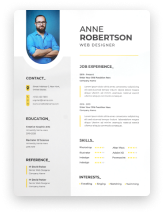Introduction
The role of a school teacher is both challenging and rewarding, requiring a unique blend of skills, knowledge, and passion. In this guide, we delve into the nuances of crafting a resume specifically tailored for school teachers. With the education sector constantly evolving, it's crucial to present a resume that not only showcases your experience and qualifications but also demonstrates your ability to adapt to the latest educational trends and technologies. Whether you're a seasoned educator or stepping into the world of teaching, this guide will provide you with all the tools you need to create a resume that stands out in the competitive field of education.

School Teacher Resume Example
Jessica Nguyen
456 Education Road, Scholarsville, MA 02108
(555) 321-6543 | jessica.nguyen@example.com
Professional Summary
Dedicated and enthusiastic School Teacher with over 7 years of experience in fostering a nurturing and stimulating educational environment for students in grades 1-5. Skilled in developing creative lesson plans that engage students and encourage a love of learning. Committed to the holistic development of each student and to working collaboratively with colleagues and parents to optimize student success.
Work Experience
Elementary School Teacher
Bright Futures Academy, Boston, MA
September 2016 - Present
- Developed and implemented innovative lesson plans across all core subjects for grades 1-5.
- Integrated technology and hands-on activities to enhance student learning and engagement.
- Conducted ongoing assessments to monitor student progress and adjust teaching strategies.
- Collaborated with parents and colleagues to support the academic and social development of students.
Assistant Teacher
Sunnyvale Elementary School, Cambridge, MA
September 2013 - August 2016
- Assisted lead teachers in planning and executing educational activities for students.
- Provided individualized support to students in need of additional academic or emotional assistance.
- Managed classroom activities and ensured a safe and inclusive learning environment.
- Participated in parent-teacher conferences and contributed to student progress reports.
Education
Master of Education in Elementary Education
Harvard Graduate School of Education, Cambridge, MA
Graduated: May 2013
GPA: 4.0
Bachelor of Science in Early Childhood Education
Boston University, Boston, MA
Graduated: May 2011
GPA: 3.8
Skills
- Curriculum Development and Lesson Planning
- Classroom Management and Student Engagement
- Individualized Instruction and Assessment
- Effective Communication and Collaboration
- Proficient in Educational Technology and Tools
Certifications
- Licensed Teacher (Massachusetts)
- ESL Teaching Certification
Resume Format or Structure
When structuring your resume, consider the format that best showcases your strengths and experiences in the field of education. A chronological format is ideal for those with a steady career progression in teaching, as it highlights your professional journey and growth. However, if you're transitioning from another field into teaching, or have gaps in your employment, a functional or combination resume may be more effective. This approach allows you to focus on your skills and achievements that are relevant to a teaching position, regardless of when and where they were acquired.
-
Chronological Resume: List your work experience in reverse chronological order, emphasizing your teaching roles and responsibilities. -
Functional Resume: Focus on your skills and qualifications, such as classroom management, curriculum development, and student engagement, rather than the chronological order of your employment. -
Combination Resume: Merge the two formats by highlighting relevant skills and achievements along with a brief work history.
Remember, no matter which format you choose, clarity and conciseness are key. Ensure that your resume is easy to read, well-organized, and free of jargon that might confuse non-educational professionals.
Resume Summary or Objective
A compelling resume summary or objective is crucial for capturing the attention of school administrators and HR professionals. This section should concisely convey your teaching philosophy, experience, and what you aim to bring to the role.
Resume Summary
A resume summary is ideal for experienced educators. It should highlight your years of experience, key achievements, and the qualities that make you a unique candidate.
Experienced elementary school teacher with over 10 years of dedicated service. Proven track record in fostering student-centered learning environments, integrating innovative educational technologies, and achieving high academic results. Recognized for exceptional skills in curriculum design and adaptation to accommodate diverse learning styles.
Resume Objective
For new teachers or those transitioning from another field, a resume objective focuses on your career goals and how they align with the needs of the school. It should reflect your enthusiasm, potential, and educational philosophy.
Enthusiastic and creative recent graduate with a Bachelor of Education, specializing in special education. Passionate about inclusive learning and committed to applying modern teaching methods to enhance student engagement and success. Eager to contribute fresh perspectives and innovative strategies in a dynamic teaching environment.
Your summary or objective is your first opportunity to make an impression, so ensure it's tailored, concise, and reflective of your passion for education.
Work Experience
Your work experience section is where you can showcase your teaching career in detail. Highlight your roles, responsibilities, and achievements in each position, focusing on how you've contributed to student learning and school improvement.
How to Structure Your Work Experience Section
-
Start with your most recent job and work backward.
-
Include the school name, your job title, and the dates of your employment.
-
Under each position, list your responsibilities and achievements using bullet points for clarity.
John Doe Elementary School, Anytown, USA
5th Grade Teacher | September 2018 - Present
-
Developed and implemented a comprehensive curriculum that improved standardized test scores by 15%.
-
Integrated technology into lesson plans, enhancing student engagement and facilitating remote learning during school closures.
-
Collaborated with colleagues to organize a successful after-school tutoring program for students needing extra assistance.
Tailoring Your Experience
-
Emphasize aspects of your previous jobs that are most relevant to the teaching position you're applying for.
-
Use action verbs to describe your duties and achievements (e.g., developed, implemented, led).
-
Include any special projects or initiatives you were part of, especially those that demonstrate leadership, innovation, or a direct impact on student success.
Remember, the goal is to show potential employers that you have the experience and skills necessary to be an effective teacher in their school.
Education
In the education section of your resume, you'll detail your academic qualifications, which are particularly crucial in the field of teaching. This section helps schools understand your foundational knowledge and training in education.
How to Structure Your Education Section
-
Start with your highest degree and proceed in reverse chronological order.
-
Include the name of each institution, the degree obtained, and the dates of attendance.
-
Mention any honors, awards, or relevant coursework.
Master of Education in Curriculum and Instruction
Xavier University, Philadelphia, Penn
Graduated May 2019
-
Graduated Summa Cum Laude
-
Specialized in Advanced Educational Technologies
Bachelor of Arts in Elementary Education
Auburn College, City, State
Graduated May 2015
-
Minor in Child Psychology
-
Dean's List for 4 consecutive years
Additional Educational Achievements
If you have additional certifications, such as a teaching certificate or specialized training (e.g., ESL certification, special education endorsement), list them in this section or create a separate section for certifications.
Recent Graduates
If you're a recent graduate, you can enhance this section by including relevant student-teaching experiences, academic achievements, and extracurricular activities that demonstrate skills applicable to a teaching position.
Skills
The skills section of your resume is a critical component, especially for a school teacher, as it succinctly outlines your teaching abilities and classroom competencies. This section should be tailored to reflect the skills most sought after in the education sector.
Essential Skills for School Teachers
-
Classroom Management: Demonstrating your ability to maintain a positive, structured learning environment. -
Curriculum Development: Showcasing your experience in creating and adapting curriculum materials. -
Technological Proficiency: Highlighting your skills in using educational technology, which is increasingly important in modern classrooms. -
Communication Skills: Both written and verbal communication skills are essential for effective teaching and collaboration with colleagues and parents. -
Adaptability: Teachers often need to adjust their teaching methods to suit different learning styles and classroom dynamics.
-
Proficient in classroom management and student engagement
-
Experienced in curriculum development and assessment design
-
Skilled in integrating technology into the classroom (familiar with tools like Google Classroom and Kahoot!)
-
Strong communication and interpersonal skills
-
Adaptable and responsive to diverse learning environments
Customizing Your Skills Section
While listing your skills, consider the specific requirements of the job you're applying for. Tailor this section to align with the qualifications listed in the job posting. This not only shows that you are a good fit for the role but also helps your resume pass through Applicant Tracking Systems (ATS) that many schools use.
Additional Sections
Adding additional sections to your resume can provide a more comprehensive picture of your qualifications and interests, especially in fields that directly relate to education. These sections can include certifications, awards, volunteer experience, or any other relevant accomplishments.
Certifications and Endorsements
If you have additional certifications or endorsements that are relevant to the teaching position, make sure to include them. These could include special education certifications, ESL endorsements, or any other specialized training.
Certifications Section Example for a School Teacher
-
Certified in Special Education, State of XYZ, 2021
-
ESL Endorsement, ABC Institute, 2020
Awards and Honors
Any awards or recognitions you've received, either academically or professionally, can be listed to highlight your achievements and dedication to the field of education.
Awards Section Example for a School Teacher
-
Teacher of the Year, John Doe Elementary School, 2019
-
Excellence in Teaching Award, XYZ School District, 2018
Volunteer Experience
Volunteering, especially in educational or community-based roles, demonstrates your commitment to education and community engagement. This experience is particularly valuable if it's related to teaching or mentoring.
Volunteer Experience Example for a School Teacher
-
Volunteer Tutor, ABC Community Center, 2017-Present
-
Summer Camp Counselor, Outdoor Education Camp, 2016
Professional Memberships
Membership in professional organizations can show your commitment to staying current in your field.
Professional Memberships Example for a School Teacher
-
Member, National Education Association, since 2018
-
Member, American Association of Curriculum Development, since 2020
Including these additional sections can set you apart from other candidates by showcasing your diverse skills, experiences, and commitments beyond the classroom.
Cover Letter
Your cover letter is an essential complement to your resume, offering a more personal narrative of your professional journey as a teacher. It's an opportunity to express your enthusiasm for the role, explain your qualifications in more depth, and convey your teaching philosophy.
Structure of a Teacher's Cover Letter
-
Introduction: Start with a strong opening that captures attention. Mention the specific teaching position you're applying for and how you heard about it. -
Body: In one or two paragraphs, delve into your teaching experience, accomplishments, and why you're a great fit for the role and the school. Highlight your most relevant experiences and connect them to the requirements listed in the job posting. -
Conclusion: End with a strong closing statement. Express your eagerness to bring your skills to the school and your enthusiasm for contributing to the students' learning journey. Provide your contact information and thank the reader for considering your application.
Dear [School Name] Hiring Committee,
I am writing to express my interest in the 5th Grade Teacher position at XYZ Elementary School, as advertised on [where you found the job posting]. With over 10 years of dedicated experience in elementary education, I am enthusiastic about the opportunity to contribute to your school's commitment to high academic standards and student-centered learning.
Tailoring Your Cover Letter
-
Customize each cover letter for the specific school and position.
-
Use the job description as a guide to highlight your skills and experiences that align with what they're looking for.
-
Mention any specific programs, initiatives, or aspects of the school that resonate with you, showing that you've done your research and are genuinely interested in becoming part of their community.
Your cover letter should be a reflection of your passion for teaching and your commitment to the development of young learners. It's your chance to make a memorable impression and show why you are the ideal candidate for the position.
Further Sections and Final Thoughts
Further Sections
Depending on your personal career journey and the specific teaching position you're applying for, you might consider adding other sections to your resume. These could include:
-
Professional Development: Highlight any ongoing learning or professional development courses you've undertaken, especially those relevant to the latest trends in education. -
Languages: If you're proficient in languages other than English, this can be a valuable asset in today's multicultural classrooms. -
Interests and Hobbies: While not always necessary, sharing your interests can humanize your application and show a well-rounded personality. This is especially relevant if your interests align with extracurricular activities or school programs.
Final Thoughts
Crafting a resume and cover letter for a school teacher position requires a careful balance of professionalism, personal touch, and a clear demonstration of your educational philosophy and accomplishments. Remember to:
-
Tailor your application to each specific job and school.
-
Highlight your unique experiences and skills that make you an ideal candidate.
-
Keep your documents clear, concise, and free of jargon or unnecessary information.
-
Proofread your resume and cover letter to ensure they are error-free.
Your application is your first opportunity to make an impression on potential employers. Make sure it reflects your passion for teaching, your commitment to student success, and your readiness to contribute to the school community.
Key Takeaway
In conclusion, a well-crafted resume and cover letter are your tickets to securing a school teacher position. They should not only showcase your qualifications and experiences but also convey your enthusiasm for teaching and your ability to positively impact students' lives. Use this guide as a starting point to create a compelling application that stands out in the competitive field of education.

FAQ about How to Write a School Teacher Resume
Q1: How long should my teaching resume be?
A1: Ideally, a teaching resume should be one to two pages long. Focus on the most relevant experiences and skills related to the teaching position you are applying for. Keep it concise but comprehensive.
Q2: Should I include references on my resume?
A2: It's not necessary to include references on your resume. Instead, prepare a separate list of professional references and submit it when requested by the employer.
Q3: How can I make my resume stand out?
A3: Tailor your resume to the specific teaching position and school. Highlight your unique skills, achievements, and experiences that align with the job requirements. Use a clear, professional format and include a strong resume summary or objective.
Q4: How important are keywords in a teaching resume?
A4: Keywords are very important, especially if the school uses Applicant Tracking Systems (ATS). Use keywords from the job description, focusing on specific skills, qualifications, and educational technologies relevant to the teaching position.
Q5: Can I include volunteer experience on my teaching resume?
A5: Absolutely. Volunteer experiences, especially those related to education or mentoring, can significantly enhance your resume. They demonstrate your commitment to community and education beyond formal employment.
Q6: How do I mention a career gap in my resume?
A6: If you have a gap in your employment history, address it positively. Focus on any relevant activities you were involved in during that time, such as further education, volunteering, or freelance work.
Q7: Is it necessary to customize my resume for each job application?
A7: Yes, it's highly recommended. Customizing your resume for each application shows that you have taken the time to understand the school's needs and how you can meet them. It also helps your resume pass through ATS.
Q8: Should I include a cover letter with my teaching resume?
A8: Yes, always include a cover letter unless specifically instructed not to. A cover letter allows you to go into more detail about your teaching philosophy and how you can contribute to the specific school.
Remember, a well-crafted resume and cover letter are crucial for making a strong first impression. Tailor them to reflect your strengths, experiences, and passion for teaching, ensuring they align with the requirements of the position you're applying for.
Recommended Reading






